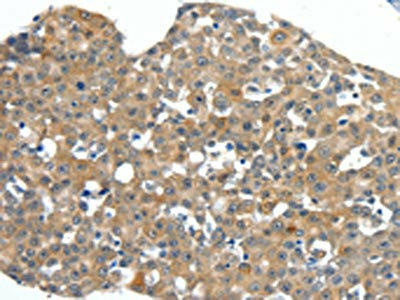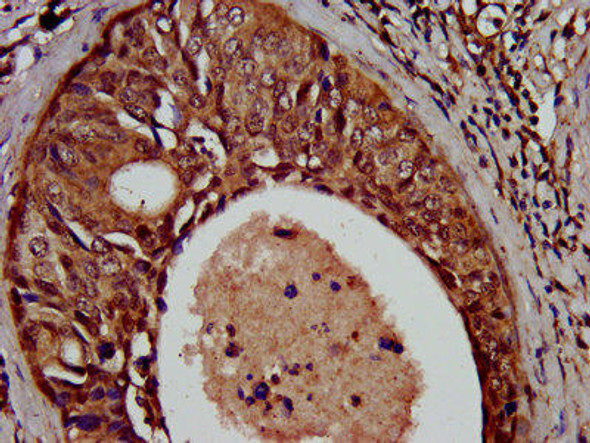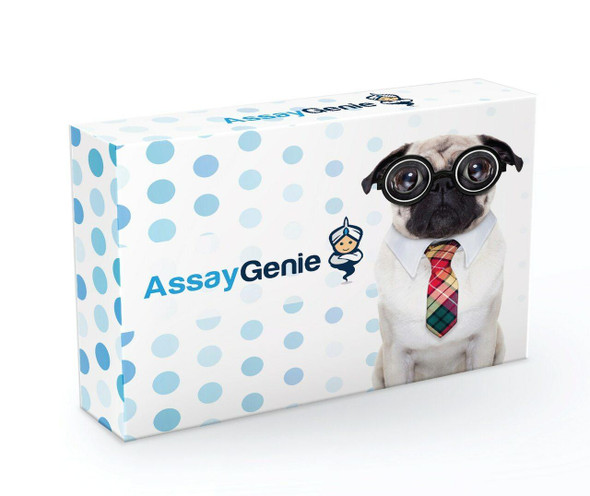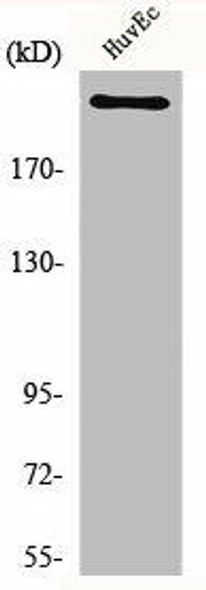Description
SCN11A Antibody (PACO18878)
The SCN11A Polyclonal Antibody (PACO18878) is a specialized research tool designed for studying the SCN11A gene, which encodes for the voltage-gated sodium channel Nav1.9. Nav1.9 is known for its role in sensory neuron excitability and pain signaling, making it a target of interest in pain research and drug development.This antibody, produced in rabbits, is highly specific to human samples and has been validated for use in Western blot applications. By binding to the SCN11A protein, researchers can analyze its expression and function in various cell types, providing valuable insights into pain mechanisms and potential therapeutic targets.
SCN11A has been implicated in various pain disorders, including neuropathic pain and inflammatory pain conditions. Understanding its role in sensory neuron excitability and pain transmission is crucial for developing novel treatments for chronic pain conditions and improving patient care.Overall, the SCN11A Polyclonal Antibody is a valuable tool for researchers interested in exploring the role of Nav1.9 in pain signaling pathways and developing targeted therapies for pain management.
| Antibody Name: | SCN11A Antibody (PACO18878) |
| Antibody SKU: | PACO18878 |
| Size: | 50ul |
| Host Species: | Rabbit |
| Tested Applications: | ELISA, IHC |
| Recommended Dilutions: | ELISA:1:2000-1:5000, IHC:1:50-1:200 |
| Species Reactivity: | Human, Mouse, Rat |
| Immunogen: | Synthetic peptide of human SCN11A |
| Form: | Liquid |
| Storage Buffer: | -20°C, pH7.4 PBS, 0.05% NaN3, 40% Glycerol |
| Purification Method: | Antigen affinity purification |
| Clonality: | Polyclonal |
| Isotype: | IgG |
| Conjugate: | Non-conjugated |
 | The image on the left is immunohistochemistry of paraffin-embedded Human breast cancer tissue using PACO18878(SCN11A Antibody) at dilution 1/40, on the right is treated with synthetic peptide. (Original magnification: x200). |
 | The image on the left is immunohistochemistry of paraffin-embedded Human esophagus cancer tissue using PACO18878(SCN11A Antibody) at dilution 1/40, on the right is treated with synthetic peptide. (Original magnification: x200). |
| Background: | Voltage-gated sodium channels are membrane protein complexes that play a fundamental role in the rising phase of the action potential in most excitable cells. α subunits, such as SCN11A, mediate voltage-dependent gating and conductance, while auxiliary β subunits regulate the kinetic properties of the channel and facilitate membrane localization of the complex. Aberrant expression patterns or mutations of α subunits underlie a number of disorders. Each α subunit consists of 4 domains connected by 3 intracellular loops; each domain consists of 6 transmembrane segments and intra- and extracellular linkers. |
| Synonyms: | sodium channel, voltage-gated, type XI, α subunit |
| UniProt Protein Function: | Function: This protein mediates the voltage-dependent sodium ion permeability of excitable membranes. Assuming opened or closed conformations in response to the voltage difference across the membrane, the protein forms a sodium-selective channel through which sodium ions may pass in accordance with their electrochemical gradient. It is a tetrodotoxin-resistant sodium channel isoform. Also involved, with the contribution of the receptor tyrosine kinase NTRK2, in rapid BDNF-evoked neuronal depolarization. Ref.1 Ref.3 |
| UniProt Protein Details: | Subunit structure: The voltage-resistant sodium channel consists of an ion conducting pore forming alpha-subunit regulated by one or more auxiliary subunits SCN1B, SCN2B and SCN3B. Subcellular location: Membrane; Multi-pass membrane protein By similarity. Tissue specificity: Expressed in the dorsal root ganglia and trigeminal ganglia, olfactory bulb, hippocampus, cerebellar cortex, spinal cord, spleen, small intestine and placenta. Ref.2 Ref.5 Domain: The sequence contains 4 internal repeats, each with 5 hydrophobic segments (S1,S2,S3,S5,S6) and one positively charged segment (S4). Segments S4 are probably the voltage-sensors and are characterized by a series of positively charged amino acids at every third position. Post-translational modification: Phosphorylation at Ser-1341 by PKC in a highly conserved cytoplasmic loop slows inactivation of the sodium channel and reduces peak sodium currents By similarity. Sequence similarities: Belongs to the sodium channel (TC 1.A.1.10) family. Nav1.9/SCN11A subfamily. [View classification] |
| NCBI Summary: | This proto-oncogene, highly-expressed in a variety of tumor cell lines, belongs to the sevenless subfamily of tyrosine kinase insulin receptor genes. The protein encoded by this gene is a type I integral membrane protein with tyrosine kinase activity. The protein may function as a growth or differentiation factor receptor. [provided by RefSeq, Jul 2008] |
| UniProt Code: | Q9UI33 |
| NCBI GenInfo Identifier: | 19924165 |
| NCBI Gene ID: | 6098 |
| NCBI Accession: | NP_002935.2 |
| UniProt Secondary Accession: | Q9UI33,Q15368, Q5TDB5, |
| UniProt Related Accession: | P08922 |
| Molecular Weight: | 263,915 Da |
| NCBI Full Name: | proto-oncogene tyrosine-protein kinase ROS |
| NCBI Synonym Full Names: | ROS proto-oncogene 1, receptor tyrosine kinase |
| NCBI Official Symbol: | ROS1 |
| NCBI Official Synonym Symbols: | ROS; MCF3; c-ros-1 |
| NCBI Protein Information: | proto-oncogene tyrosine-protein kinase ROS |
| UniProt Protein Name: | Sodium channel protein type 11 subunit alpha |
| UniProt Synonym Protein Names: | Peripheral nerve sodium channel 5; PN5; Sensory neuron sodium channel 2; Sodium channel protein type XI subunit alpha; Voltage-gated sodium channel subunit alpha Nav1.9; hNaN |
| Protein Family: | Protein |
| UniProt Gene Name: | SCN11A |
| UniProt Entry Name: | SCNBA_HUMAN |
















